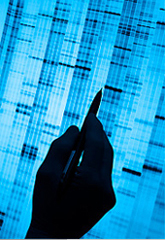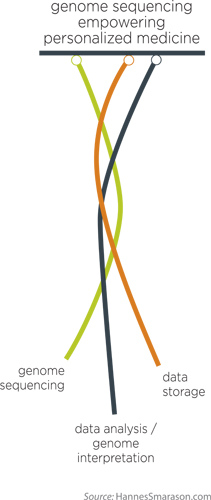
The achievement of low-cost genome sequencing and the use of genomic data to better understand diseases are advancing the exciting new era of personalized medicine.
It’s been more than a decade since the human genome was first sequenced. Since then, we have been on the journey of applying this profound new discovery to create personalized medicine and advance human health.
Two significant triumphs along this human genome journey:
- Using genomic data to better understand diseases; and
- Achieving low-cost genome sequencing.
Each of these accomplishments has been a stepping stone into the exciting new era that is dawning now: where genomic information is becoming integrated into medical care.
Using Genomic Data to Better Understand Diseases
Let’s take a look back at the early days of using genomic data to connect the dots between genetic mutations and disease. From 1997-2004, I was part of the leadership team at deCODE, the Icelandic genomic company. This was the period when deCODE was building the world’s most productive human genomics platform, with a database of tens of thousands of individuals who participated in genetic studies and including the largest database of genomes to this day. deCODE’s genomic engine was able to successfully identify the genetic variations associated with human disease. This resulted in dozens of groundbreaking discoveries that were published in major, peer-reviewed journals.
The legacy of deCODE was the creation of an industrialized platform capable of massive storage and analysis capabilities. This enabled researchers to crunch genomic data to gain insights about genetic variants, or risk factors, associated with many common diseases. deCODE’s premise was that once the genetics of disease was better understood that information could be used to create new ways to diagnose, treat and prevent disease. However, when I left deCODE in 2004, there were still barriers to overcome before this genomic information could be widely applied to the level of an individual patient. Chief among them was that the cost of genome sequencing was still prohibitively high. (deCODE was subsequently acquired by Amgen).
Achieving Low-Cost Genome Sequencing
Back in 2004, the cost to sequence a single human genome was hundreds of thousands of dollars. Today that cost is a few thousand dollars (and, in fact, fast approaching $1,000) for a whole genome sequence. DNA sequencing costs continue to fall, as speed and accuracy increase.
This means we are rapidly approaching a tipping point where, as the sequencing of human genomes becomes more economical, its adoption in the medical community becomes more widespread and genomic data can become more routine in medical care. This is why personalized medicine is becoming a reality.
The Era of Genome Sequencing in Medical Care
The steep drop in the costs of sequencing, combined with the explosion of research on gene variants and disease, mean the time is fast approaching when genome sequencing will become routine in medical care. Today, pathologists perform blood cultures to decide which antibiotics will stop a patient’s bacterial infection. Soon a patient sample can be taken to perform a genome sequencing to analyze the genetic characteristics of a patient to determine ways a disease can be prevented or, if they are sick, which treatments might work best for their disease.
The body of genomic knowledge and the large databank of human genomes built by pioneers like deCODE established the key building blocks that enable genome sequencing to have predictive power for individual patients. As more human genomes are sequenced and more genetic variants are associated with disease, the predictive power of knowing about risk genes and effective treatments for each patient – a.k.a. personalized medicine – will become an essential part of medical care.
Genome Sequencing Being Implemented by Medical Centers
In preparation for the future of personalized medicine, major medical centers in the U.S., Europe and Asia are actively beginning to install DNA sequencers and supercomputers as important tools for integrating genome sequencing into medical care. These medical centers are taking initial steps toward the routine sequencing of every patient’s genome to define the ideal course of prevention and treatment based on variants found in a patient’s genes.
Evidence of this adoption of genome sequencing by medical centers appeared in an article in The New York Times in April 2013 citing that:
- Medical centers in New York City are spending more than $1 billion on new genomic research centers;
- Several hospitals around the U.S. are undertaking systematic genome sequencing in patients;
- Mount Sinai Medical Center has a program in which 24,000 patients participate in a biobank to include their DNA sequence and research over their lifetimes;
- Memorial Sloan-Kettering Cancer Center sequenced 16,000 tumors from cancer patients in 2012; and
- Phoenix Children’s Hospital opened a new institute in December 2012 to sequence the genomes of 30 percent of their childhood cancer patients.
For now, the use of whole genome sequencing in medical practice is still in its infancy, but the pace of progress continues to accelerate. Clearly, genome sequencing will soon become part of the nucleus of medical care. This will herald a new era in personalized medicine revolutionizing healthcare as we know it and transforming our lives. When do you think genome sequencing will become a part of the medical decisions in your life?










